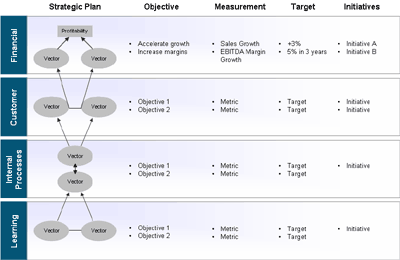Strategic Planning with the Balanced Scorecard Framework
Balanced Scorecard is a technique that enables better strategic planning in business.
The Balanced Scorecard presents a succinct summary of financial and non-financial metrics. It is the method by which this 'most relevant' information is determined (i.e. the design processes used to select the content) that most differentiates the various versions of the tool in circulation.
 Modern Balanced Scorecard thinking has evolved considerably since the initial ideas proposed in the late 1980s and early 1990s, and the modern performance management tools including Balanced Scorecard are significantly improved - being more flexible (to suit a wider range of organisational types) and more effective (as design methods have evolved to make them easier to design, and use).
Modern Balanced Scorecard thinking has evolved considerably since the initial ideas proposed in the late 1980s and early 1990s, and the modern performance management tools including Balanced Scorecard are significantly improved - being more flexible (to suit a wider range of organisational types) and more effective (as design methods have evolved to make them easier to design, and use).
The balanced scorecard is appropriately used to implement a strategic plan. There are four steps to designing a balanced scorecard:
- Translating the vision into operational goals
- Communicating the vision and link it to individual performance
- Business planning; index setting
- Feedback and learning, and adjusting the strategy accordingly
Operational issues can be considered from the following perspectives:
- Financial: encourages the identification of a few relevant high-level financial measures. In particular, designers were encouraged to choose measures that helped inform the answer to the question 'How do we look to shareholders?'
- Customer: encourages the identification of measures that answer the question 'How do customers see us?'
- Internal Business Processes: encourages the identification of measures that answer the question 'What must we excel at?'
- Learning and Growth: encourages the identification of measures that answer the question 'Can we continue to improve and create value?'
The Balanced Scorecard is ultimately about choosing measures and targets. Various design methods are intended to help in the identification of these measures and targets, usually by a process of abstraction that narrows the search space for a measure (e.g. find a measure to inform about a particular 'objective' within the Customer perspective, rather than simply finding a measure for 'Customer').
Other Strategic Planning Frameworks
- 4P's Marketing Mix
- Seven S (7S) Management Framework
- AIDA - Attention, Interest, Desire, Action - Buying Process
- Ansoff's Matrix - Product-Market Growth Matrix - Expansion Strategy
- BCG Growth-Share Matrix
- Bass Diffusion Model - Product Adoption and Innovation
- Blue Ocean Strategy
- Choice Model for Decision-Making Behavior
- Competitive Advantage
- Core Competence - Collective Learning in the Organization
- Cost-Benefit Analysis
- Delta Model
- ERG (Existence, Relatedness, Growth) Theory of Motivation
- Experience Curve
- Framing Effect on Psychology and Marketing
- GE (McKinsey) Matrix
- Growth Phases
- Predicting Industry Evolution and Change
- OODA Loop - Observe, Orient, Decide, Act
- PDCA (Plan, Do, Check, Act) - The Deming Cycle
- PEST Analysis - Political, Economical, Social, Technological, Environmental, and Legal Factors
- Perceptual Mapping - Brand Marketing
- Porter's Five Forces
- Product and Marketing Positioning
- Product Lifecycle (Industry Lifecycle)
- Root Cause Analysis
- SWOT Analysis - Strengths, Weaknesses, Opportunties, Threats
- Technology Adoption Curve
- Value Chain
- Balanced Scorecard
- Benchmarking
- Customer Segmentation
- Pricing Strategy & Price Optimization
- Mergers and Acquisitions (M&A)

SATISFACTION GUARANTEE
We have helped thousands of businesses with their research, and we are confident we can help you, too. We offer a 7-Day Money Back Guarantee on all purchases.

